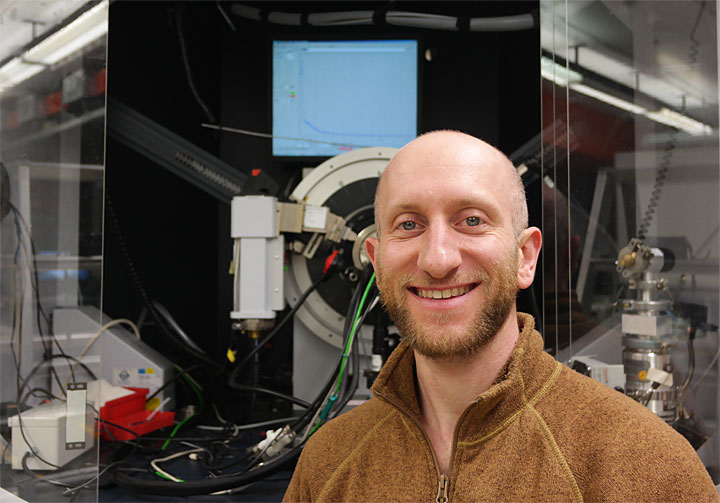Maxwell Terban Receives 2018 Julian David Baumert Ph.D. Thesis Award
Maxwell Terban received the 2018 Julian Baumert Ph.D. Thesis Award at this year's Joint CFN and NSLS-II Users' Meeting.
June 21, 2018
Written by Gretchen Cisco
 enlarge
enlarge
Maxwell Terban, a postdoctoral researcher at the Max-Plank Institute for Solid State Research, Stuttgart, is this year's recipient of the Julian Baumert Ph.D. Thesis Award.
Maxwell Terban, a postdoctoral researcher at the Max-Plank Institute for Solid State Research, Stuttgart, is this year’s recipient of the Julian Baumert Ph.D. Thesis Award. Terban was selected for developing new research methods, based around a technique called pair distribution function (PDF), for extracting and analyzing structural signatures from materials. His research incorporated measurements from the now-closed National Synchrotron Light Source (NSLS) and the recently opened National Synchrotron Light Source II (NSLS-II)—a U.S. Department of Energy (DOE) Office of Science User Facility located at Brookhaven National Laboratory.
Each year, the Baumert Award is given to a researcher who has recently conducted a thesis project that included measurements at NSLS or NSLS-II. The award was established in memory of Julian David Baumert, a young Brookhaven physicist who worked on x-ray studies of soft-matter interfaces at NSLS.
Terban holds a bachelor’s degree in chemical engineering from the University of Massachusetts, Amherst, and a master’s degree in materials science and engineering from Columbia University. He graduated with a Ph.D. in materials science and engineering from Columbia University in 2018, and completed his doctoral dissertation under the guidance of Simon Billinge, a professor of materials science and engineering and applied physics and mathematics at Columbia.
Terban began his research at a time when Billinge’s group started exploring whether PDF could add value to the study of organics. Billinge notes that he was very lucky to have Max as a student at this time.
“It was Max’s work that showed PDF’s bright future in the large community of organic materials, from pharmaceuticals to polymers and dyes, and all the way electronic organics,” Billinge said.
To address the issue of defects in material properties—which are very difficult to detect and analyze in a quantitative way—Terban developed methods based around the PDF technique for extracting and analyzing structural signatures from minority phases. These phases, for example, are dilute nanocrystals in inhalant drug suspensions, just-nucleated crystalline seeds in recrystallizing pharmaceuticals, and the structure of particles and ions loaded into zeolites and metal-organic frameworks. High-energy beamlines at NSLS and at NSLS-II were key to incorporating this technique, as they provided a wide range of momentum transfer and exceptional scattering conditions.
With his concentration on pharmaceuticals, Terban showed that minority nanocrystalline phases can be detected, fingerprinted, and modeled for mixed crystalline and amorphous systems of small molecules. He demonstrated this capability while investigating the effects of amorphization process on lactose, which is commonly used as an excipient, filler, and binder material in food and pharmaceuticals.
Overall, the PDF methods and interpretation for soft, weakly scattering materials were enhanced and verified during Terban’s thesis, and developed and applied toward phase detections, identification, solution and behavior in pharmaceuticals, polymers, and nanoporous materials.
Terban accepted the Baumert Award on May 23, 2018, during the 2018 NSLS-II and CFN Users’ Meeting. He received a $600 honorarium and travel arrangements to the meeting, where he gave a presentation on his thesis work.
“I am convinced that Max’s work will turn out to be seminal, and it is already turning heads,” Billinge said.
Brookhaven National Laboratory is supported by the Office of Science of the U.S. Department of Energy. The Office of Science is the single largest supporter of basic research in the physical sciences in the United States, and is working to address some of the most pressing challenges of our time. For more information, please visit science.energy.gov.
Follow @BrookhavenLab on Twitter or find us on Facebook.
2018-12969 | INT/EXT | Newsroom









